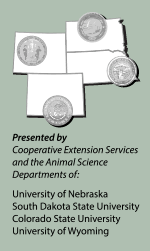Health Observations After Atlas
by Kasey Brown, associate editor, Angus Journal
RAPID CITY, S.D. (Dec. 4, 2013) — It has been two months since massive Winter Storm Atlas hit South Dakota and other areas of the Northern Plains. There is no official number, but losses of up to 20,000 head have been reported, said Russ Daly, Extension veterinarian for South Dakota State University.

Many factors contributed to the devastation caused by Winter Storm Atlas, said Russ Daly, Extension veterinarian for South Dakota State University.
Many factors contributed to the blizzard’s devastation. It hit early, and started with rain. Cattle were still in summer pastures and still had their summer hair coats. The rain soaked the cattle to the skin, and temperatures dropped dramatically. The wet summer hair reduced their lower critical temperature — the lowest temperature an animal can endure without burning energy to keep warm — to 59° F, he explained. With wind chills, temperatures reached 12°-16°. This meant cows needed to increase energy intake by 47%-94% just to maintain. It resulted in hypothermia.
The blizzard also caused entrapment in fences and in mud, resulting in exhaustion, drowning in creeks and stock dams, exhaustion on dry land, and pulmonary edema.
Pulmonary edema, he described, looked like “gallons of fluid” pouring from the nose and mouth of carcasses when moved. That much stress on an animal’s system causes the blood vessels to constrict and increased resistance in the systemic arteries. This means the heart has to work harder to pump against the resistance. The stress caused the kidneys to hold on to sodium and water, causing increased blood volume and blood pressure. The heart wears out against that much extra fluid and resistance, so fluid enters the airways, and the animal “drowns standing up.”
Following the storm, cattle have shown signs of “transport tetany,” including being hyperexcitable, tremors then recumbency, Daly said. It’s brought on by long-term feed and water deprivation, then rapid resumption. It is exacerbated by grass tetany caused by the fall green-up in pastures.
Calves have been more prone to bloat from disruptions in feedings. Behavioral changes, namely aggression, have also been observed, he added.
In the weeks after the storm, signs of a long-term stress event are still evident. Cattle have increased blood cortisol levels, which causes shifts in the immune system that reduce vaccine response and increase susceptibility to the bovine respiratory disease complex (BRDC), especially to native viruses. He also noted that he has observed many cases of pinkeye.
There are also reproductive implications. Some fetal losses have been observed in very stressed animals, but, he said, he didn’t think fetal losses would be widespread. However, it is unknown what effects there will be once those calves are born.
Daly suggested a few lessons could be learned from the storm:
- Be prepared for potential similar weather conditions to cause tetany conditions, bloat and pinkeye.
- Manage feed resumption, though that is not something that can be easily remedied.
- Adjust management to allow for stress levels in cattle to level out, especially for administering vaccines.
- Animal identification is important when cattle can end up miles away from home due to destroyed fences or covered fences.
- Remember, good management and proper animal care may not always be enough against Mother Nature.
There really was nothing good that came of this blizzard, he concluded, except that it showcased human kindness and resilience.
Daly spoke Wednesday at RBCS XXIII. Visit the Newsroom at www.rangebeefcow.com/2013 to view his PowerPoint or listen to his presentation.
---------------------
The RBCS is a biennial educational symposium offering practical production management information. It is sponsored by the Cooperative Extension Service and animal science departments of the University of Wyoming, South Dakota State University, Colorado State University and the University of Nebraska.
Comprehensive coverage of the symposium is available online at www.rangebeefcow.com. Compiled by the Angus Journal editorial team, the site is made possible through sponsorship of LiveAuctions.tv and the cooperation of the host committee.
Editor’s Note: This article was written under contract or by staff of the Angus Journal. To request reprint permission and guidelines, contact Shauna Rose Hermel, editor, at 816-383-5270.
.


